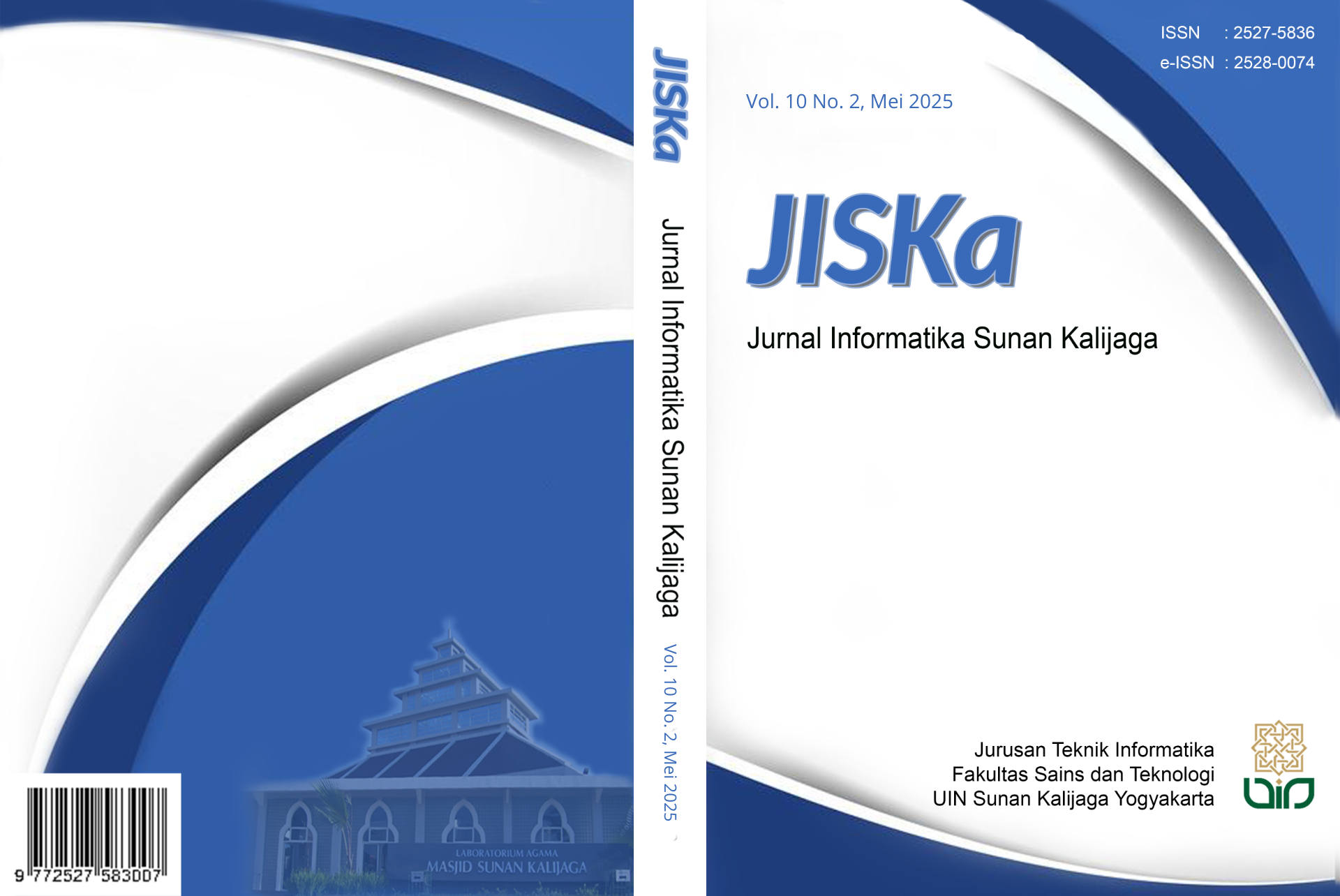Analisis Sentimen Ulasan Pengguna Aplikasi Alfagift Menggunakan Random Forest
DOI:
https://doi.org/10.14421/jiska.2025.10.2.158-170Keywords:
Sentimen Analysis, Alfagift, Random Forest, Text Mining, ReviewAbstract
Alfagift is a mobile application developed by Alfamart to support online ordering, with features such as promos, transactions, ordering, and delivery from the nearest point according to the consumer's address. User feedback on the Google Play Store shows mixed sentiments, including both positive and negative responses, which can be utilized by developers as material to improve the quality of the application. This study focuses on assessing the sentiment of Alfagift app user reviews through the application of the Random Forest algorithm. A total of 4,379 review data was collected from the Google Play Store and grouped into two categories, namely positive and negative sentiment. The research steps include data collection, data labeling, data preprocessing, word weighting, data division into training and testing sets, Random Forest algorithm implementation, and model evaluation. The test results show that the Random Forest algorithm achieves an accuracy of 97.6% and an AUC of 0.98, which falls into the category of excellent classification. This research is expected to contribute to application developers in understanding user perceptions, so as to improve application quality and increase overall user convenience.
References
Anjani, A. F., Anggraeni, D., & Tirta, I. M. (2023). Implementasi Random Forest Menggunakan SMOTE untuk Analisis Sentimen Ulasan Aplikasi Sister for Students UNEJ. Jurnal Nasional Teknologi dan Sistem Informasi, 9(2), 163–172. https://doi.org/10.25077/TEKNOSI.v9i2.2023.163-172
Arista, D., Sibaroni, Y., & Prasetyo, S. S. (2024). Sentiment Analysis on Twitter (X) Related to Relocating the National Capital using the IndoBERT Method Using Extraction Features of Chi-Square. Jurnal Media Informatika Budidarma, 8(1), 403. https://doi.org/10.30865/mib.v8i1.7198
Fadli, M. N., SJ, A. S., & Nafiah, N. (2023). Mekanisme Penggunaan Member Card Alfagift dalam Jual Beli Perspektif Hukum Islam (Studi Kasus di Alfamart Ponorogo). Social Science Academic, 1(2), 29–36. https://doi.org/10.37680/ssa.v1i2.3173
Firdaus, A. (2024). Analisis Sentimen pada Aplikasi Alfagift Menggunakan Metode Naïve Bayes Classifier [UIN Syarif HIdayatullah]. https://repository.uinjkt.ac.id/dspace/handle/123456789/76766
Hanifa, F., Putri, C. H., N, A. F., & Wulansari, A. (2023). Analisis Penerimaan Aplikasi Alfagift di Kota Surabaya Menggunakan Metode Technology Acceptance Model. Jurnal Sains dan Teknologi (JSIT), 3(2), 233–244. https://doi.org/10.47233/jsit.v3i2.835
Hasibuan, S. S., Angraini, A., Saputra, E., & Megawati, M. (2024). Sentimen Analisis Terhadap Fitur Tiktok Shop Menggunakan Naïve Bayes dan K-Nearest Neighbor. Jurnal Media Informatika Budidarma, 8(1), 303. https://doi.org/10.30865/mib.v8i1.7238
Kadhim, A. (2018). An Evaluation of Preprocessing Techniques for Text Classification. International Journal of Computer Science and Information Security (IJCSIS), 16(6), 22–32. https://www.academia.edu/36998792/An_Evaluation_of_Preprocessing_Techniques_for_Text_Classification
Nanda, S., Mualfah, D., & Fitri, D. A. (2022). Analisis Sentimen Kepuasan Pengguna Terhadap Layanan Streaming Mola Menggunakan Algoritma Random Forest. Jurnal Aplikasi Teknologi Informasi dan Manajemen (JATIM), 3(2), 210–219. https://doi.org/10.31102/jatim.v3i2.1592
Pahlevi, O., Amrin, A., & Handrianto, Y. (2023). Implementasi Algoritma Klasifikasi Random Forest untuk Penilaian Kelayakan Kredit. Jurnal Infortech, 5(1), 71–76. https://doi.org/10.31294/infortech.v5i1.15829
Perdana, S. A., Florentin, S. F., & Santoso, A. (2022). Analisis Segmentasi Pelanggan Menggunakan K-Means Clustering Studi Kasus Aplikasi Alfagift. Sebatik, 26(2), 446–457. https://doi.org/10.46984/sebatik.v26i2.1991
Pradana, M. (2016). Klasifikasi Bisnis E-Commerce di Indonesia. Modus, 27(2), 163. https://doi.org/10.24002/modus.v27i2.554
Sidauruk, N., Riza, N., & Fatonah, Rd. N. S. (2023). Penggunaan Metode SVM dan Random Forest untuk Analisis Sentimen Ulasan Pengguna Terhadap KAI Access di Google Play Store. JATI (Jurnal Mahasiswa Teknik Informatika), 7(3), 1901–1906. https://doi.org/10.36040/jati.v7i3.6899
Styawati, S., Hendrastuty, N., & Isnain, A. R. (2021). Analisis Sentimen Masyarakat Terhadap Program Kartu Prakerja pada Twitter dengan Metode Support Vector Machine. Jurnal Informatika: Jurnal Pengembangan IT, 6(3), 150–155. https://doi.org/10.30591/jpit.v6i3.2870
Syakir, A., & Hasan, F. N. (2023). Analisis Sentimen Masyarakat Terhadap Perilaku Korupsi Pejabat Pemerintah Berdasarkan Tweet Menggunakan Naive Bayes Classifier. Jurnal Media Informatika Budidarma, 7(4), 1796. https://doi.org/10.30865/mib.v7i4.6648
Wicaksono, N. B. A. (2022). Analisis Sentimen Tingkat Kepuasan Pengguna BPJS dengan Metode SentiStrength [Universitas Atma Jaya Yogyakarta]. https://repository.uajy.ac.id/id/eprint/27165/
Wilujeng, D. T., Fatekurohman, M., & Tirta, I. M. (2023). Analisis Risiko Kredit Perbankan Menggunakan Algoritma K-Nearest Neighbor dan Nearest Weighted K-Nearest Neighbor. Indonesian Journal of Applied Statistics, 5(2), 142. https://doi.org/10.13057/ijas.v5i2.58426
Downloads
Published
How to Cite
Issue
Section
License
Copyright (c) 2025 M. Bagus Prayogi, Gustina Masitoh

This work is licensed under a Creative Commons Attribution-NonCommercial 4.0 International License.
Authors who publish with this journal agree to the following terms as stated in http://creativecommons.org/licenses/by-nc/4.0
a. Authors retain copyright and grant the journal right of first publication with the work simultaneously licensed under a Creative Commons Attribution License that allows others to share the work with an acknowledgement of the work's authorship and initial publication in this journal.
b. Authors are able to enter into separate, additional contractual arrangements for the non-exclusive distribution of the journal's published version of the work (e.g., post it to an institutional repository or publish it in a book), with an acknowledgement of its initial publication in this journal.
c. Authors are permitted and encouraged to post their work online (e.g., in institutional repositories or on their website) prior to and during the submission process, as it can lead to productive exchanges, as well as earlier and greater citation of published work.










